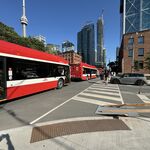Exactly.
Metrolinx and TTC are there to run the transit systems but that doesn't give them the right to dictate how you use the system.
If it's A to B on transit, it's none of their business how you decide to get there. Whether based on zones, distance, or regional doesn't matter..............the cost of getting there shouldn't be at all effected by the choice of which technology to use.
Whether you decide to get to your destination on standard rail gauge, third rail, LRT tracks, legacy tracks, LIM rail or just good old fashioned pavement shouldn't make any difference.
Seriously. Charging more to ride standard rail GO and slightly less for RER tracks than third rail is just as stupid as charging more for LIM tracks and LRT tracks, that legacy streetcar tracks. When you get right down to the basics that is how stupid the fare structure is and will become.
Metrolinx & the TTC should set the fares for getting from A to B but leave the choice of how they get there to the riders themselves.




